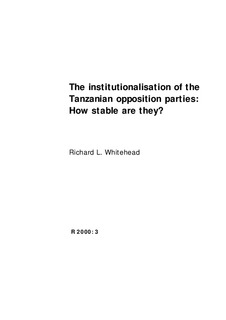| dc.description.abstract | In 1992, legislation formally ended the nearly 30 year domination of the one-party state in Tanzania, part of a democratisation wave that appeared to sweep through Africa in the late 80s and early 90s. In Tanzania by 1993, there were a total of 51 parties formally registered or in the process of registering. Today, this fragmentation has been reduced to 13 legally registered political parties.
This article, as an abstract from an MPA thesis, focuses on the institutionalisation of the five main opposition parties that have emerged since 1992: the NCCR-Mageuzi, CHADEMA, CUF, UDP, and TLP. Specifically, through the use of a four dimensional party institutionalisation model, this article discusses some of the key factors that limit these five parties in operating as stable institutions in a political environment still dominated by the incumbent regime, the Chama Cha Mapinduzi. | |
